On the Effectiveness of Vibration-Based Monitoring for Integrity Management of Prestressed Structures
Abstract
1. Introduction
2. Effect of Uncertainties on Modal Parameters
3. Effect of Damage in Ordinary and Prestressed Concrete Sections
3.1. Variation with Damage of the Flexural Rigidity in Ordinary and in Prestressed Sections
3.2. Variation with Damage of the Modal Frequencies of an Ordinary and a Prestressed Beam
4. Numerical Analyses of Ordinary and Prestressed Concrete Sections Exposed to Corrosion
4.1. Numerical Model of the Sections Damaged by Corrosion
4.2. Numerical Model of the Sections Damaged by Corrosion
4.3. Failure Probabilities Comparison between the Reinforced and the Prestressed Concrete Section
5. Discussion
6. Conclusions
Author Contributions
Funding
Data Availability Statement
Conflicts of Interest
References
- Fan, W.; Qiao, P. Vibration-based damage identification methods: A review and comparative study. Struct. Health Monit. 2011, 10, 83–111. [Google Scholar] [CrossRef]
- Deraemaeker, A.; Reynders, E.; De Roeck, G.; Kullaa, J. Vibration-based structural health monitoring using output-only measurements under changing environment. Mech. Syst. Signal Process. 2008, 22, 34–56. [Google Scholar] [CrossRef]
- Quqa, S.; Giordano, P.F.; Limongelli, M.P.; Landi, L.; Diotallevi, P.P. Clump interpolation error for the identification of damage using decentralized sensor networks. Smart Struct. Syst. 2021, 27, 351–363. [Google Scholar] [CrossRef]
- Limongelli, M.P.; Chatzi, E.; Döhler, M.; Lombaert, G.; Reynders, E. Towards extraction of vibration-based damage indicators. In Proceedings of the 8th European Workshop on Structural Health Monitoring, EWSHM 2016, Bilbao, Spain, 5–8 July 2016. [Google Scholar]
- Giordano, P.F.; Quqa, S.; Limongelli, M.P. Statistical Approach for Vibration-Based Damage Localization in Civil Infrastructures Using Smart Sensor Networks. Infrastructures 2021, 6, 22. [Google Scholar] [CrossRef]
- Kato, M.; Shimada, S. Vibration of PC bridge during failure process. J. Struct. Eng. 1986, 112, 1692–1703. [Google Scholar] [CrossRef]
- Hop, T. The effect of degree of prestressing and age of concrete beams on frequency and damping of their free vibration. Mater. Struct. 1991, 24, 210–220. [Google Scholar] [CrossRef]
- Saiidi, M.; Douglas, B.; Feng, S. Prestress force effect on vibration frequency of concrete bridges. J. Struct. Eng. 1994, 120, 2233–2241. [Google Scholar] [CrossRef]
- Unger, J.F.; Teughels, A.; De Roeck, G. System identification and damage detection of a prestressed concrete beam. J. Struct. Eng. 2006, 132, 1691–1698. [Google Scholar] [CrossRef]
- Capozucca, R. Detection of damage due to corrosion in prestressed RC beams by static and dynamic tests. Constr. Build. Mater. 2008, 22, 738–746. [Google Scholar] [CrossRef]
- Di Evangelista, A.; De Leonardis, A.D.; Valente, C.; Zuccarino, L. Design and testing of corrosion damaged prestressed concrete joists: The Pescara Benchmark. J. Phys. Conf. Ser. 2011, 305, 012081. [Google Scholar] [CrossRef]
- Miyamoto, A.; Tei, K.; Nakamura, H.; Bull, J.W. Behavior of prestressed beam strengthened with external tendons. J. Struct. Eng. N. Y. 2000, 126, 1033–1044. [Google Scholar] [CrossRef]
- Noble, D.; Nogal, M.; O’Connor, A.; Pakrashi, V. The effect of prestress force magnitude and eccentricity on the natural bending frequencies of uncracked prestressed concrete beams. J. Sound Vib. 2016, 365, 22–44. [Google Scholar] [CrossRef]
- Wang, T.-H.; Huang, R.; Wang, T.-W. The variation of flexural rigidity for post-tensioned prestressed concrete beams. J. Mar. Sci. Technol. 2013, 21, 300–308. [Google Scholar] [CrossRef]
- Limongelli, M.P.; Siegert, D.; Merliot, E.; Waeytens, J.; Bourquin, F.; Vidal, R.; Le Corvec, V.; Gueguen, I.; Cottineau, L.M. Damage detection in a post tensioned concrete beam—Experimental investigation. Eng. Struct. 2016, 128, 15–25. [Google Scholar] [CrossRef]
- Zhao, L.; Kim, C.-W.; Goi, Y.; Takemura, K. Vibration-Based Damage Detection for a Prestressed Concrete Box Girder by Means of Subspace Analysis. ASCE-ASME J. Risk Uncertain. Eng. Syst. Part A Civ. Eng. 2021, 7, 04021056. [Google Scholar] [CrossRef]
- Bonopera, M.; Chang, K.C.; Chen, C.C.; Sung, Y.C.; Tullini, N. Experimental study on the fundamental frequency of prestressed concrete bridge beams with parabolic unbonded tendons. J. Sound Vib. 2019, 455, 150–160. [Google Scholar] [CrossRef]
- De Roeck, G. The state-of-the-art of damage detection by vibration monitoring: The SIMCES experience. J. Struct. Control 2003, 10, 127–134. [Google Scholar] [CrossRef]
- Limongelli, M.P.; Tirone, M.; Surace, C. Non-destructive monitoring of a prestressed bridge with a data-driven method. In Proceedings of the SPIE—The International Society for Optical Engineering, Portland, OR, USA, 26–29 March 2017; Volume 10170. [Google Scholar]
- Giordano, P.F.; Limongelli, M.P. Response-based time-invariant methods for damage localization on a concrete bridge. Struct. Concr. 2020, 21, 1254–1271. [Google Scholar] [CrossRef]
- Abdel-Jaber, H.; Glisic, B. Monitoring of prestressing forces in prestressed concrete structures—An overview. Struct. Control Health Monit. 2019, 26, e2374. [Google Scholar] [CrossRef]
- Breccolotti, M. Eigenfrequencies of continuous prestressed concrete bridges subjected to prestress losses. Structures 2020, 25, 138–146. [Google Scholar] [CrossRef]
- Cao, L.; Liu, J.; Frank Chen, Y. Theoretical and Numerical Study on the Natural Frequencies of Bridges With Corrugated Steel Webs. Structures 2018, 15, 224–231. [Google Scholar] [CrossRef]
- Breccolotti, M.; Pozza, F. Prestress evaluation in continuous PSC bridges by dynamic identification. Struct. Monit. Maint. 2018, 5, 463–488. [Google Scholar] [CrossRef]
- Aloisio, A. Aspects of Vibration-Based Methods for the Prestressing Estimate in Concrete Beams with Internal Bonded or Unbonded Tendons. Infrastructures 2021, 6, 83. [Google Scholar] [CrossRef]
- Rainieri, C.; Fabbrocino, G. Operational Modal Analysis of Civil Engineering Structures; Springer: New York, NY, USA, 2014; ISBN 978-1-4939-0766-3. [Google Scholar]
- Katayama, T. Subspace Methods for System Identification. In Communications and Control Engineering; Springer International Publishing: Berlin/Heidelberg, Germany, 2005. [Google Scholar]
- Chen, B.; Zhao, S.L.; Li, P.Y. Application of Hilbert-Huang transform in structural health monitoring: A state-of-the-art review. Math. Probl. Eng. 2014, 2014, 317954. [Google Scholar] [CrossRef]
- Brincker, R.; Zhang, L.; Andersen, P. Modal identification of output-only systems using frequency domain decomposition. Smart Mater. Struct. 2001, 10, 441–445. [Google Scholar] [CrossRef]
- Quqa, S.; Landi, L.; Diotallevi, P.P. Instantaneous modal identification under varying structural characteristics: A decentralized algorithm. Mech. Syst. Signal Process. 2020, 142, 106750. [Google Scholar] [CrossRef]
- Kullaa, J. Distinguishing between sensor fault, structural damage, and environmental or operational effects in structural health monitoring. Mech. Syst. Signal Process. 2011, 25, 2976–2989. [Google Scholar] [CrossRef]
- Sohn, H. Effects of environmental and operational variability on structural health monitoring. Philos. Trans. R. Soc. A Math. Phys. Eng. Sci. 2007, 365, 539–560. [Google Scholar] [CrossRef] [PubMed]
- Figueiredo, E.; Park, G.; Figueiras, J.; Farrar, C.; Worden, K. Structural Health Monitoring Algorithm Comparisons Using Standard Data Sets; Technical Report LA-14393; Los Alamos National Laboratory: Los Alamos, NM, USA, 2009. [Google Scholar] [CrossRef]
- Kim, C.W.; Kawatani, M.; Hao, J. Modal parameter identification of short span bridges under a moving vehicle by means of multivariate AR model. Struct. Infrastruct. Eng. 2012, 8, 459–472. [Google Scholar] [CrossRef]
- Kim, C.Y.; Jung, D.S.; Kim, N.S.; Kwon, S.D.; Feng, M.Q. Effect of vehicle weight on natural frequencies of bridges measured from traffic-induced vibration. Earthq. Eng. Eng. Vib. 2003, 2, 109–115. [Google Scholar] [CrossRef]
- Pisani, M.A. Pre-stressing and Eurocode E.C.2. Eng. Struct. 1998, 20, 706–711. [Google Scholar] [CrossRef]
- Quayyum, S.; Hassan, T. Initial Residual Stresses in Hot-Rolled Wide-Flange Shapes: A Computational Technique and Influence on Structural Performances. J. Struct. Eng. 2017, 143, 04017013. [Google Scholar] [CrossRef]
- Jain, S.K.; Goel, S.C. Discussion of “Prestress Force Effect on Vibration Frequency of Concrete Bridges” by M. Saiidi, B. Douglas, and S. Feng. J. Struct. Eng. 1996, 122. [Google Scholar] [CrossRef]
- Pisani, M.A.; Iorio, F.P. Comparative analysis of two precast bridge beams. Ind. Ital. Cem. 2004, 74, 604–613. [Google Scholar]
- CEN. Eurocode 1—Actions on Structures—Part 2: Traffic Loads on Bridges—EN 1991-2; CEN, European Committee for Standardization: Brussels, Belgium, 2005. [Google Scholar]
- AASHTO. Standard Specifications for Highway Bridges, 17th ed.; American Association of State Highway and Transportation Officials: Washington, DC, USA, 2002; ISBN 156051-171-0. [Google Scholar]
- CEN. Eurocode 2: Design of Concrete Structures—Part 1-1: General Rules and Rules for Buildings—EN 1992-1-1; CEN, European Committee for Standardization: Brussels, Belgium, 2006. [Google Scholar]
- Pisani, M.A. A numerical method to analyse compact cross-sections. Comput. Struct. 1996, 59, 1063–1072. [Google Scholar] [CrossRef]
- Luo, Y.; Zhou, S.; Wang, C.; Fang, Z. Effects of cations in sulfate on the thaumasite form of sulfate attack of cementitious materials. Constr. Build. Mater. 2019, 229, 116865. [Google Scholar] [CrossRef]
- Zhao, G.; Li, J.; Shi, M.; Fan, H.; Cui, J.; Xie, F. Degradation mechanisms of cast-in-situ concrete subjected to internal-external combined sulfate attack. Constr. Build. Mater. 2020, 248, 118683. [Google Scholar] [CrossRef]
- Zhou, S.; Ju, J.W. A chemo-micromechanical damage model of concrete under sulfate attack. Int. J. Damage Mech. 2021, 30, 1213–1237. [Google Scholar] [CrossRef]
- Bertolini, L.; Elsener, B.; Pedeferri, P.; Polder, R. Corrosion of Steel in Concrete: Prevention, Diagnosis, Repair; Wiley-VCH, Verlag GmbH & Co., KGaA: Weinheim, Germany, 2004; ISBN 9783527603374. [Google Scholar]
- Ouzaa, K.; Oucif, C. Numerical model for prediction of corrosion of steel reinforcements in reinforced concrete structures. Undergr. Space 2019, 4, 72–77. [Google Scholar] [CrossRef]
- Pedeferri, P. Corrosion Science and Engineering; Springer: Cham, Switzerland, 2018; ISBN 978-3-319-97624-2. [Google Scholar]
- Ožbolt, J.; Oršanić, F.; Balabanić, G.; Kušter, M. Modeling damage in concrete caused by corrosion of reinforcement: Coupled 3D FE model. Int. J. Fract. 2012, 178, 233–244. [Google Scholar] [CrossRef]
- Liu, Y.; Weyers, R.E. Modeling the time-to-corrosion cracking in chloride contaminated reinforced concrete structures. Am. Concr. Inst. Mater. J. 1998, 95, 675–681. [Google Scholar] [CrossRef]
- Moawad, M.; El-Karmoty, H.; El Zanaty, A. Behavior of corroded bonded fully prestressed and conventional concrete beams. HBRC J. 2018, 14, 137–149. [Google Scholar] [CrossRef]
- Caspeele, R.; Steenbergen, R.; Sykora, M. Partial Factor Methods for Existing Concrete Structures; fib Bulletin No. 80, Germany; 2016; ISBN 978-2-88394-120-5. Available online: https://www.fib-international.org/publications/fib-bulletins/partial-factor-methods-for-existing-concrete-structures-161-detail.html (accessed on 29 November 2021).
- Koteš, P.; Vičan, J. Reliability Levels for Existing Bridges Evaluation According to Eurocodes. Procedia Eng. 2012, 40, 211–216. [Google Scholar] [CrossRef][Green Version]
- Thoft-Christensen, P.; Nowak, A. Principles of Bridge Reliability: Application to Design and Assessment Codes; Structural Reliability Theory, No. 162, Volume R9751; Deptartment of Building Technology and Structural Engineering: Aalborg, Denmark, 1997. [Google Scholar]
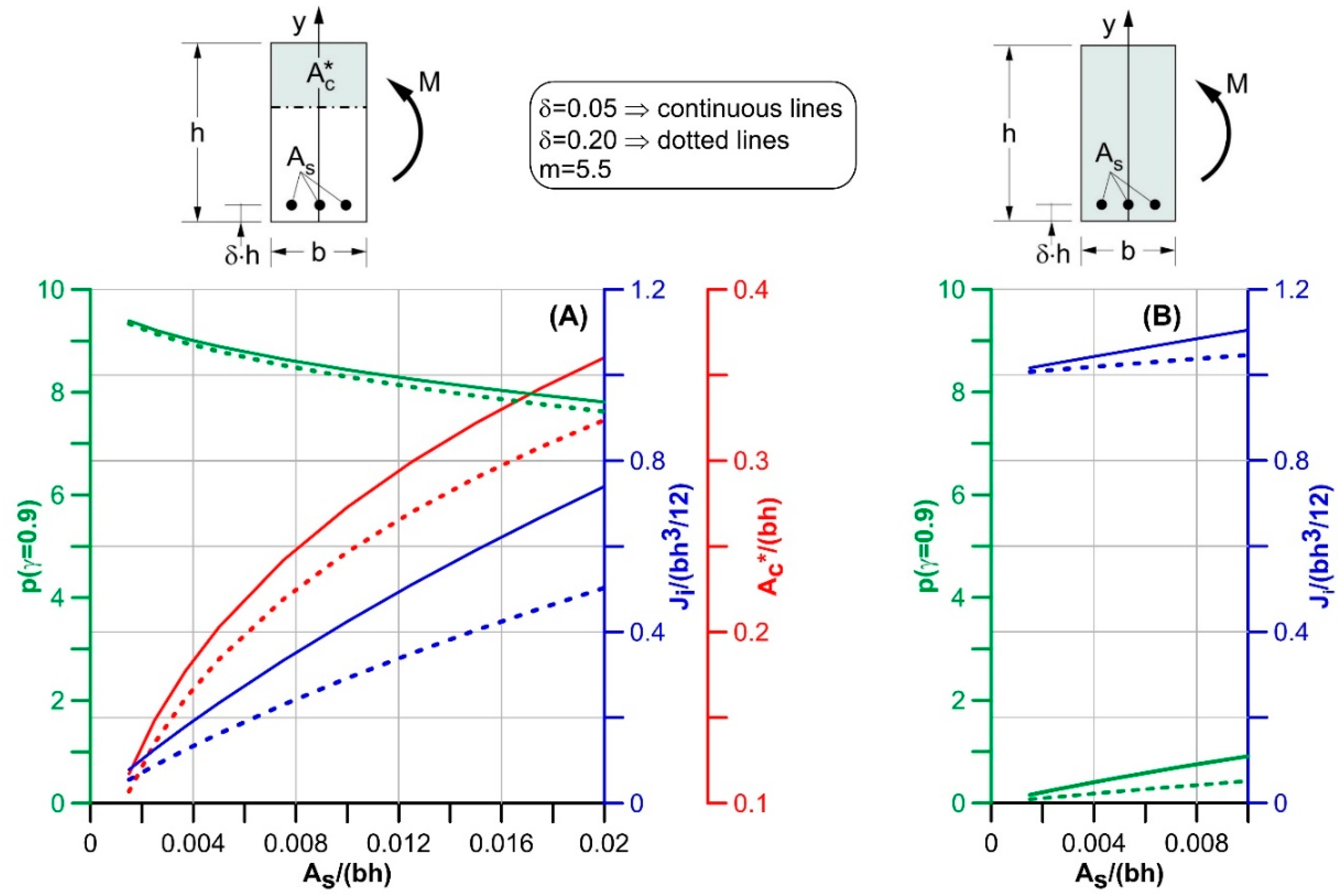
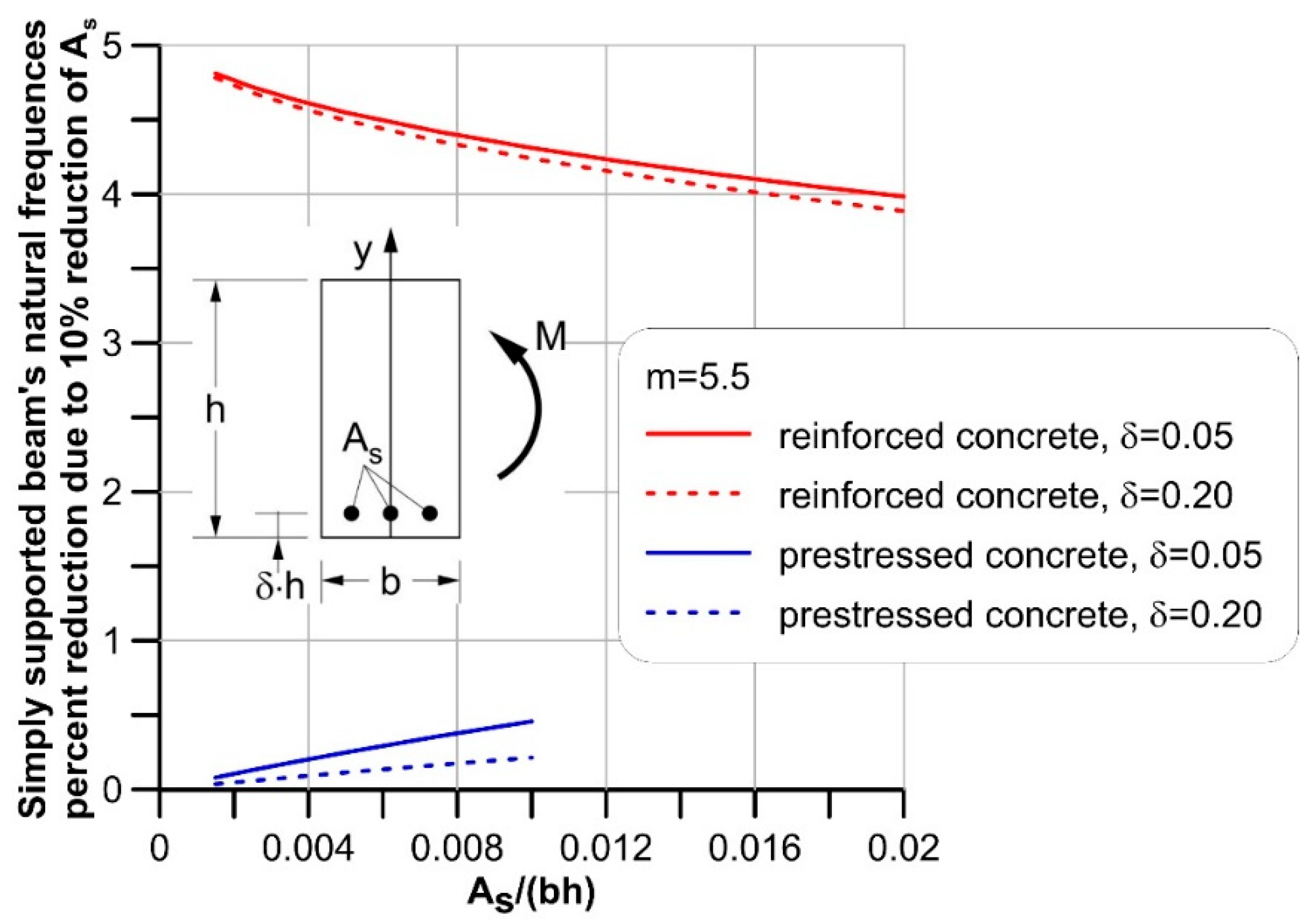
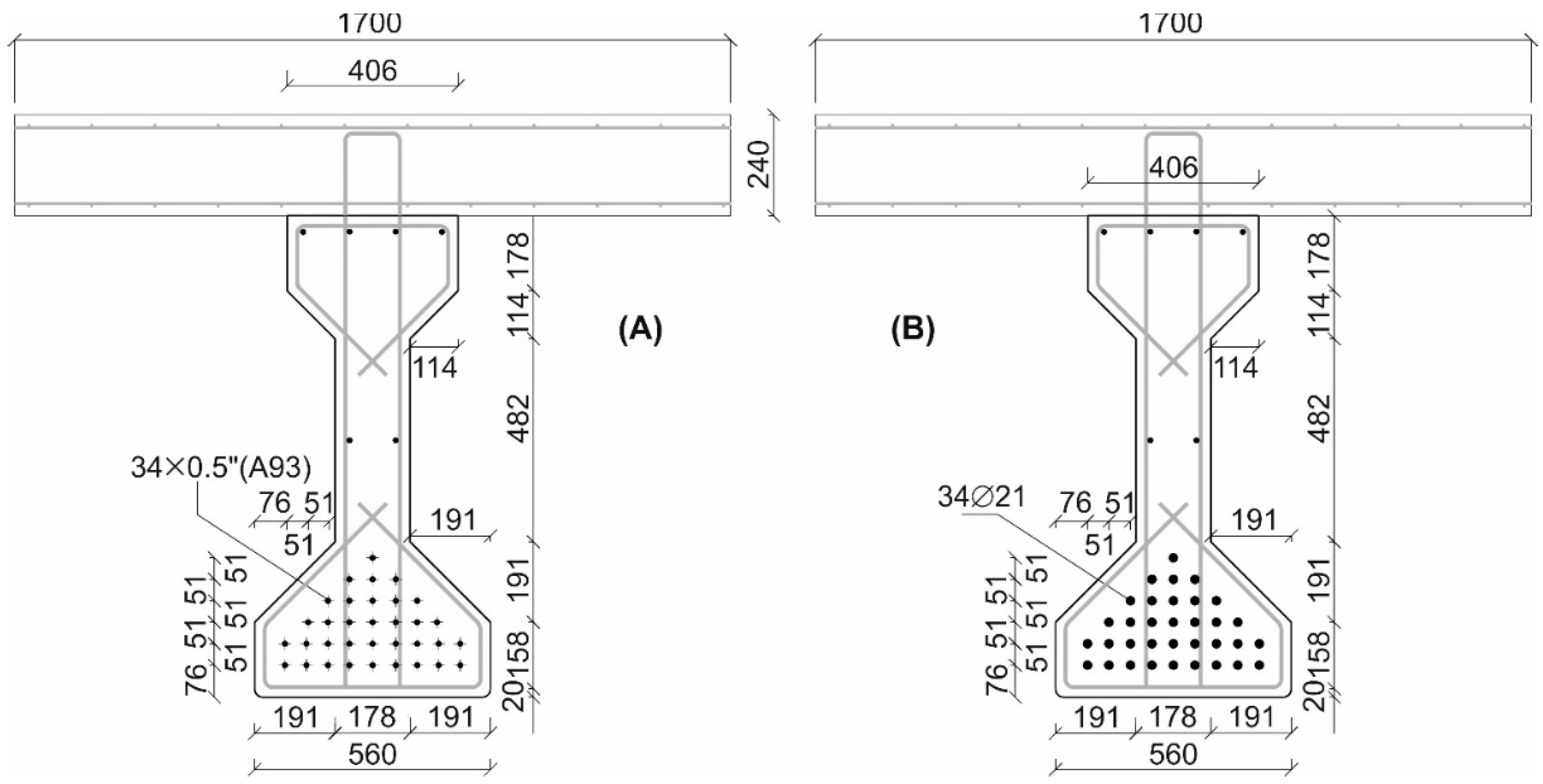
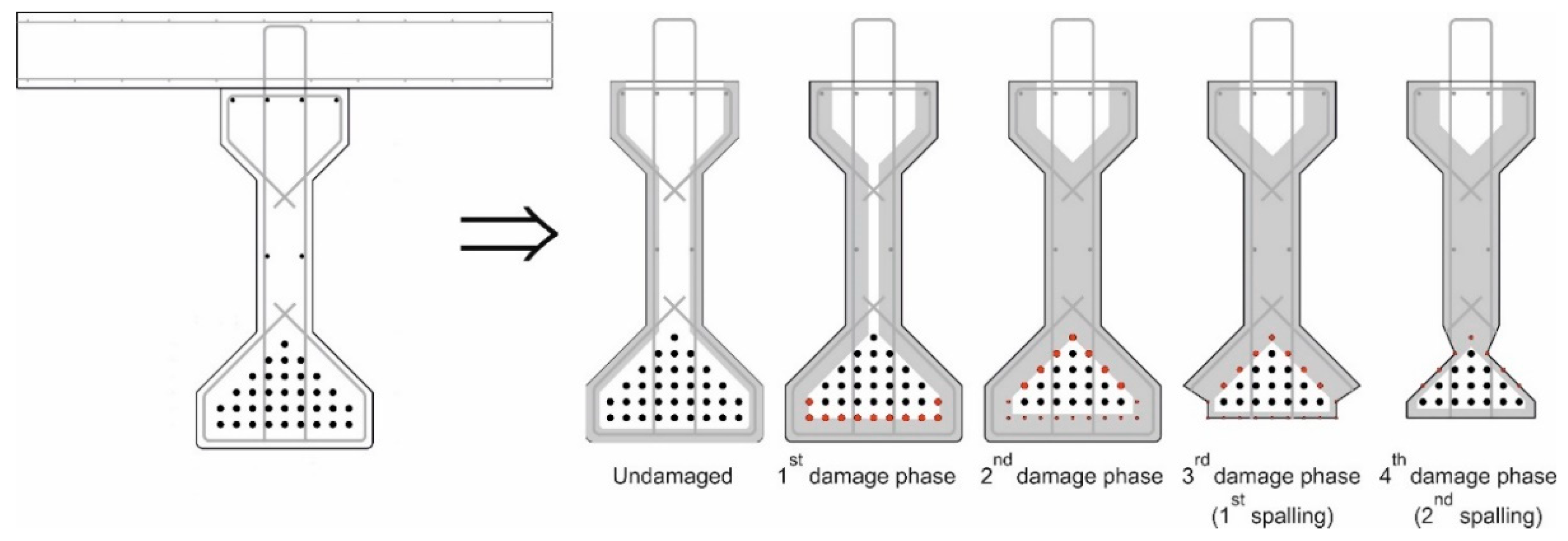
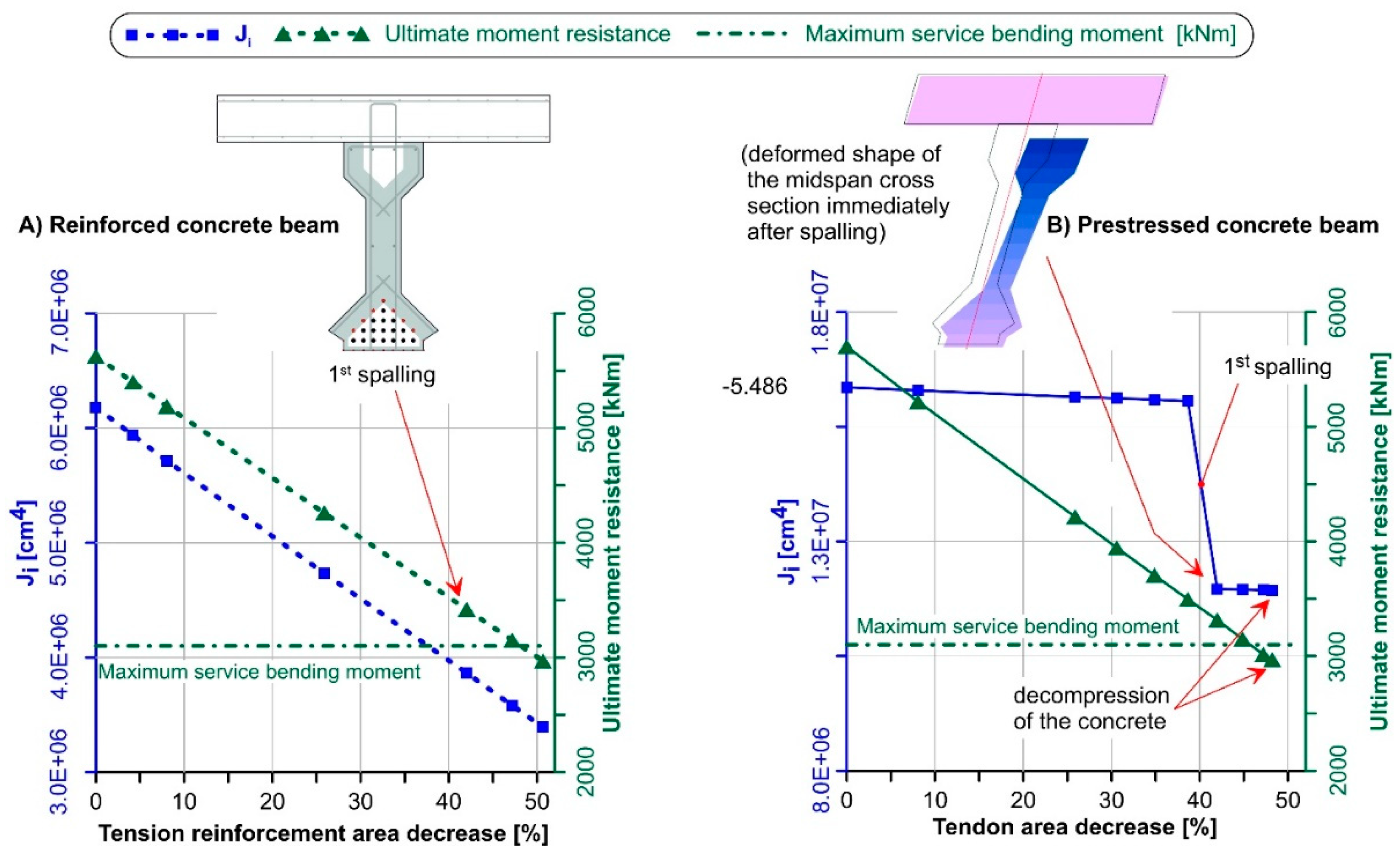
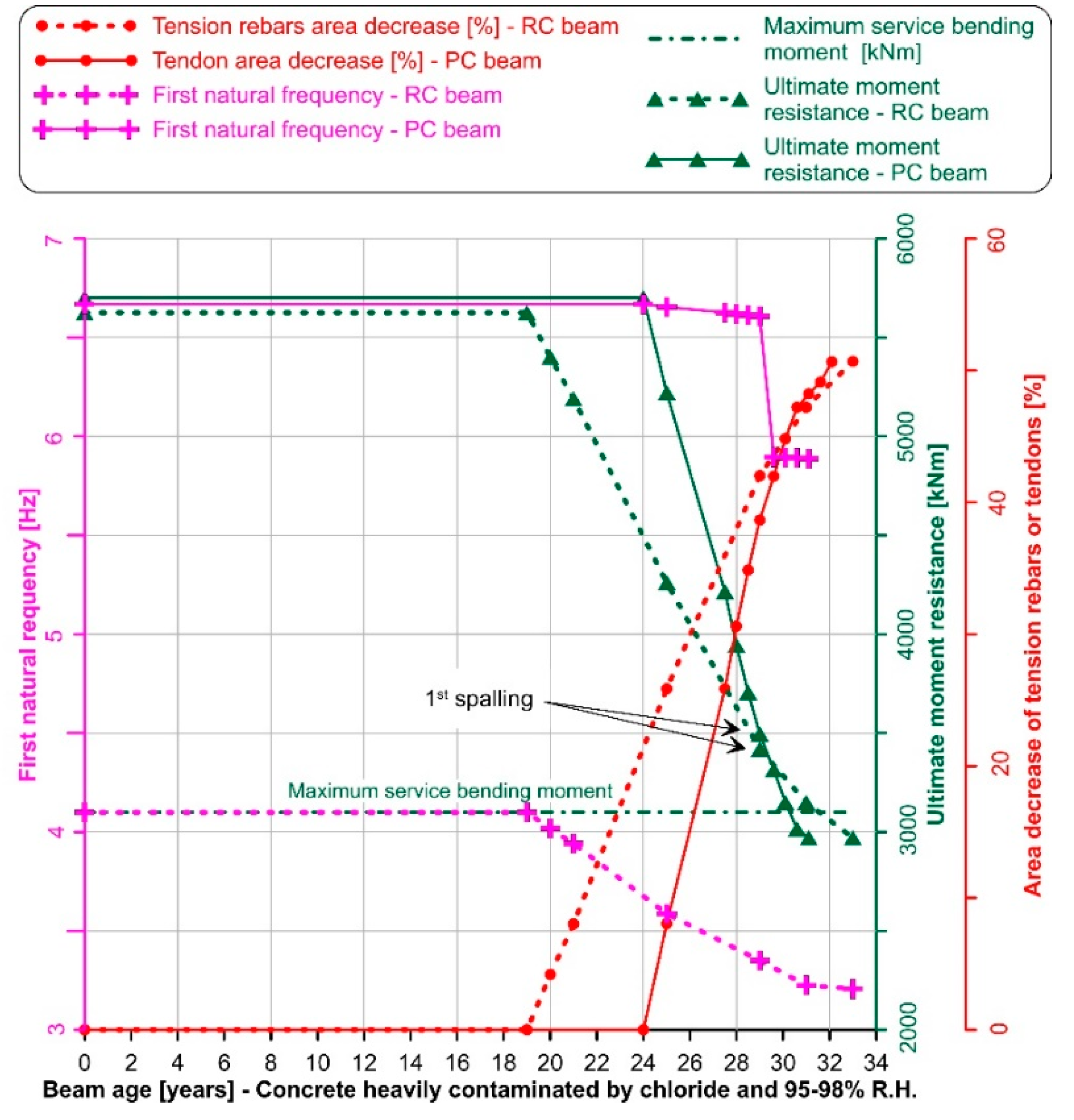
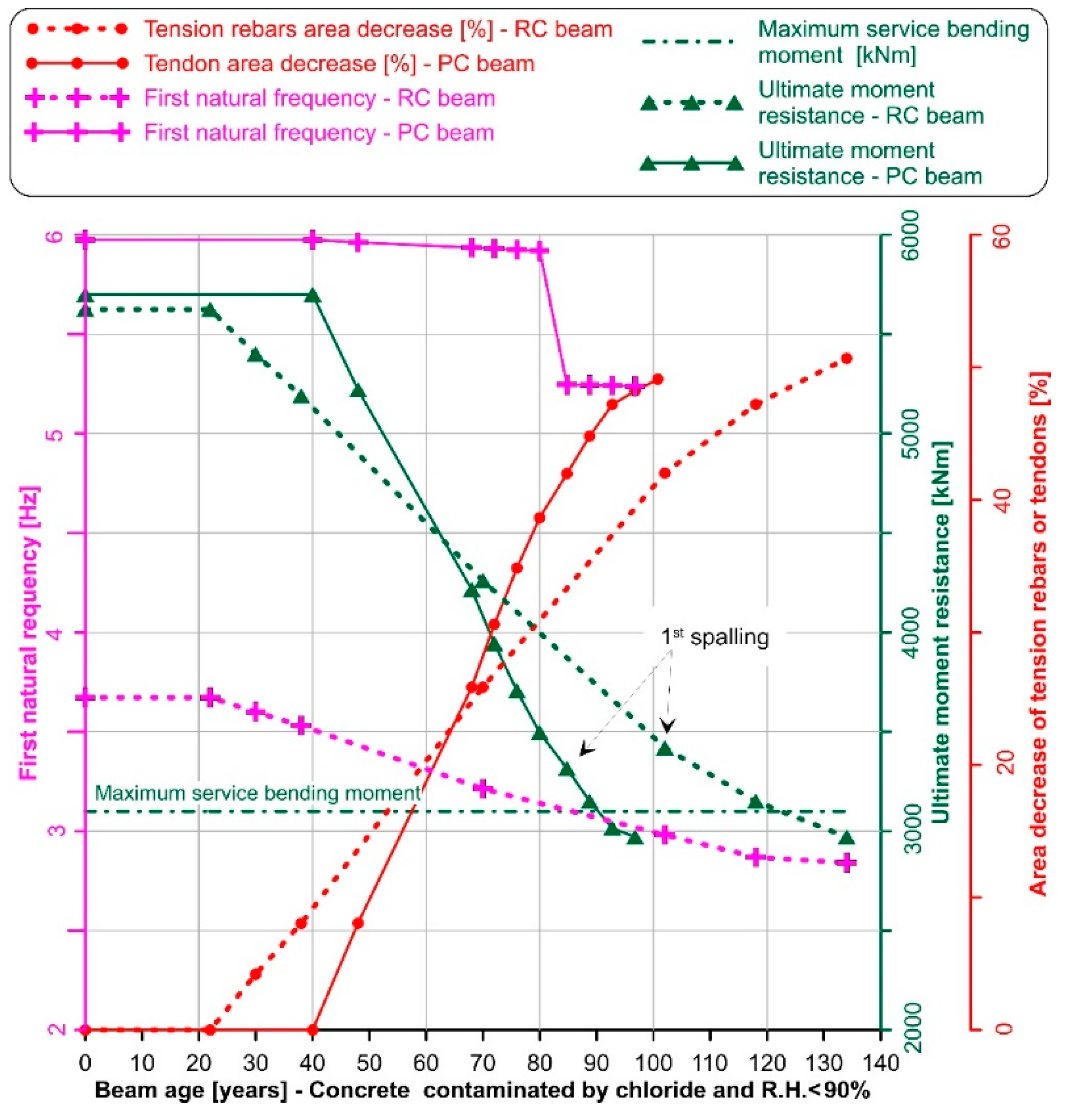
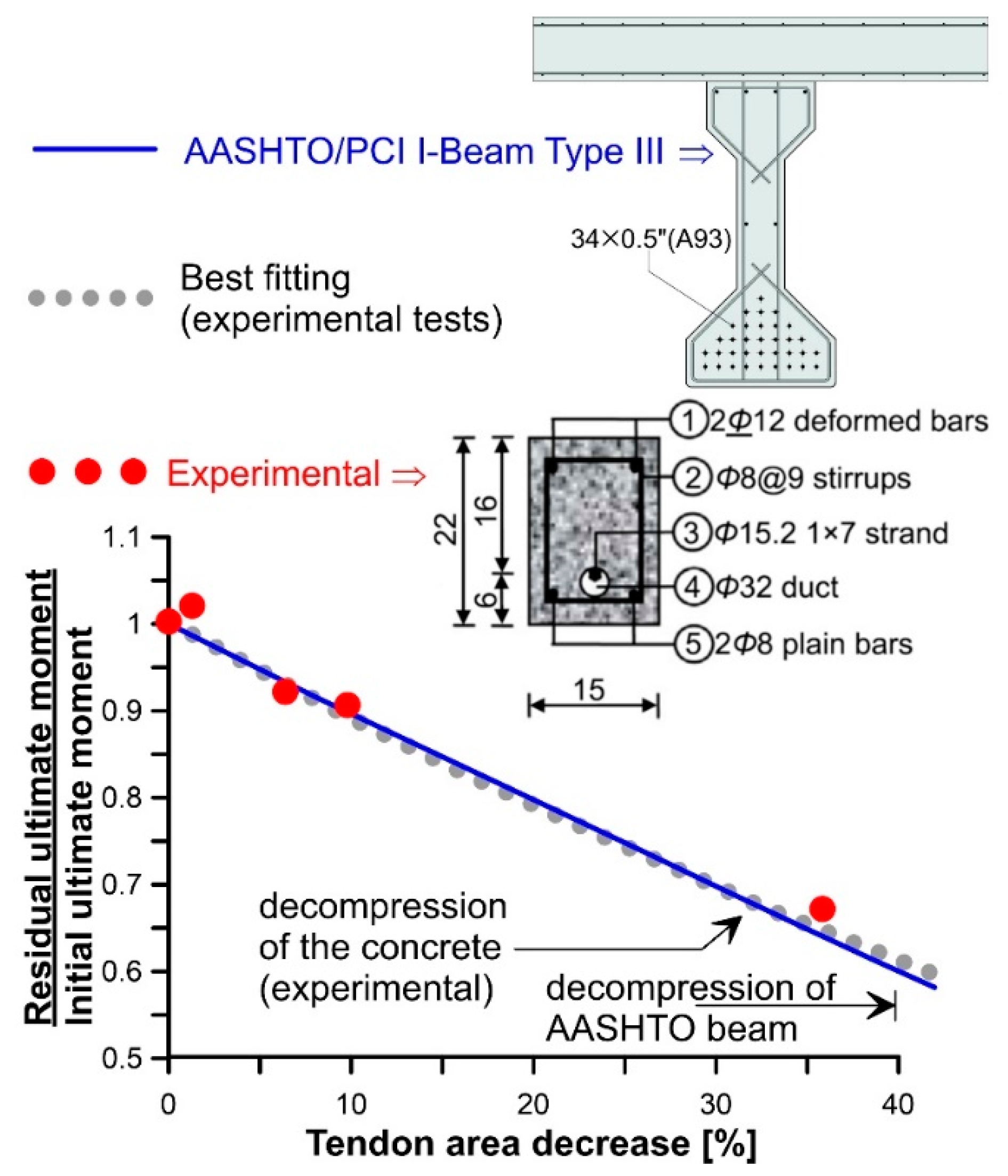
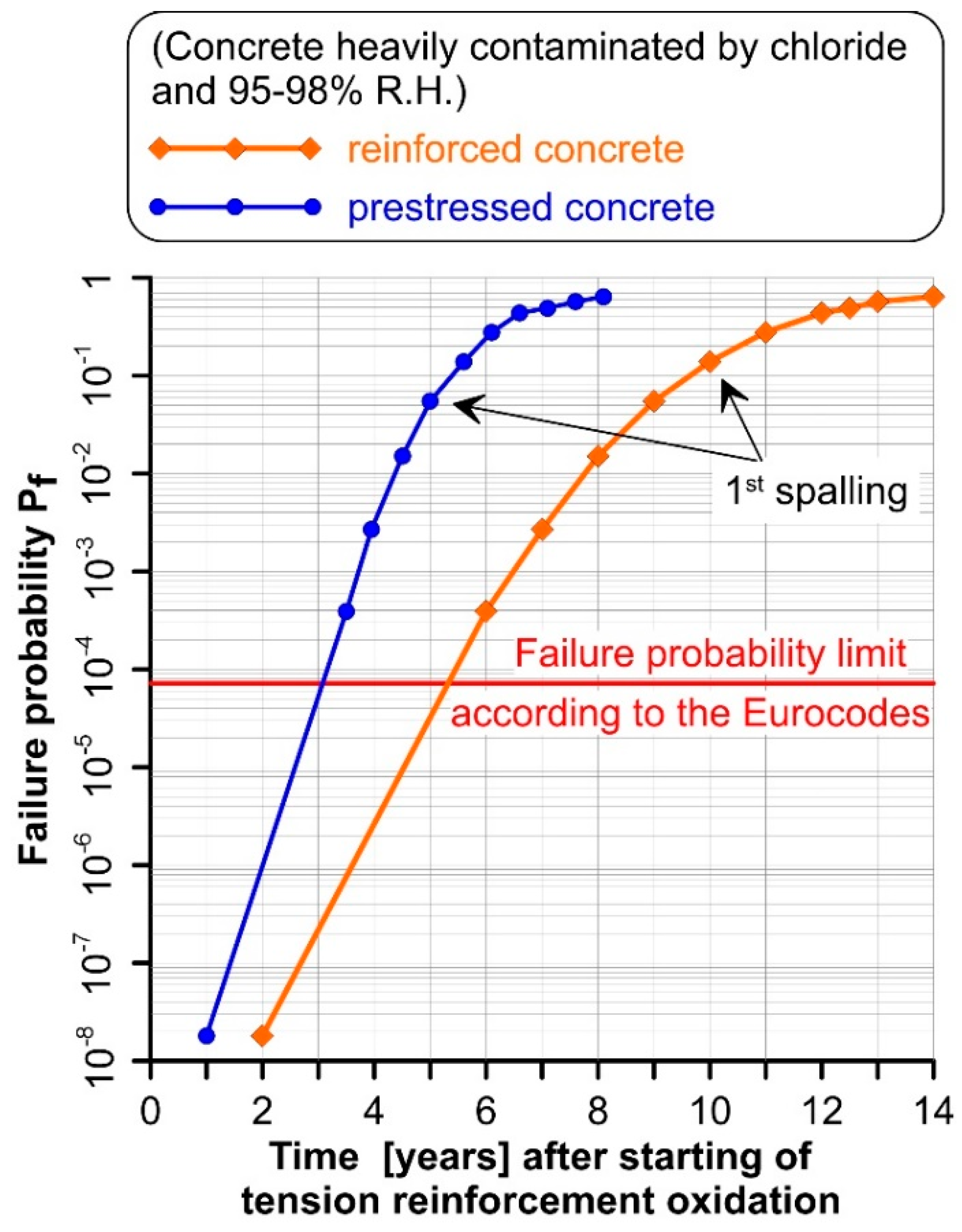
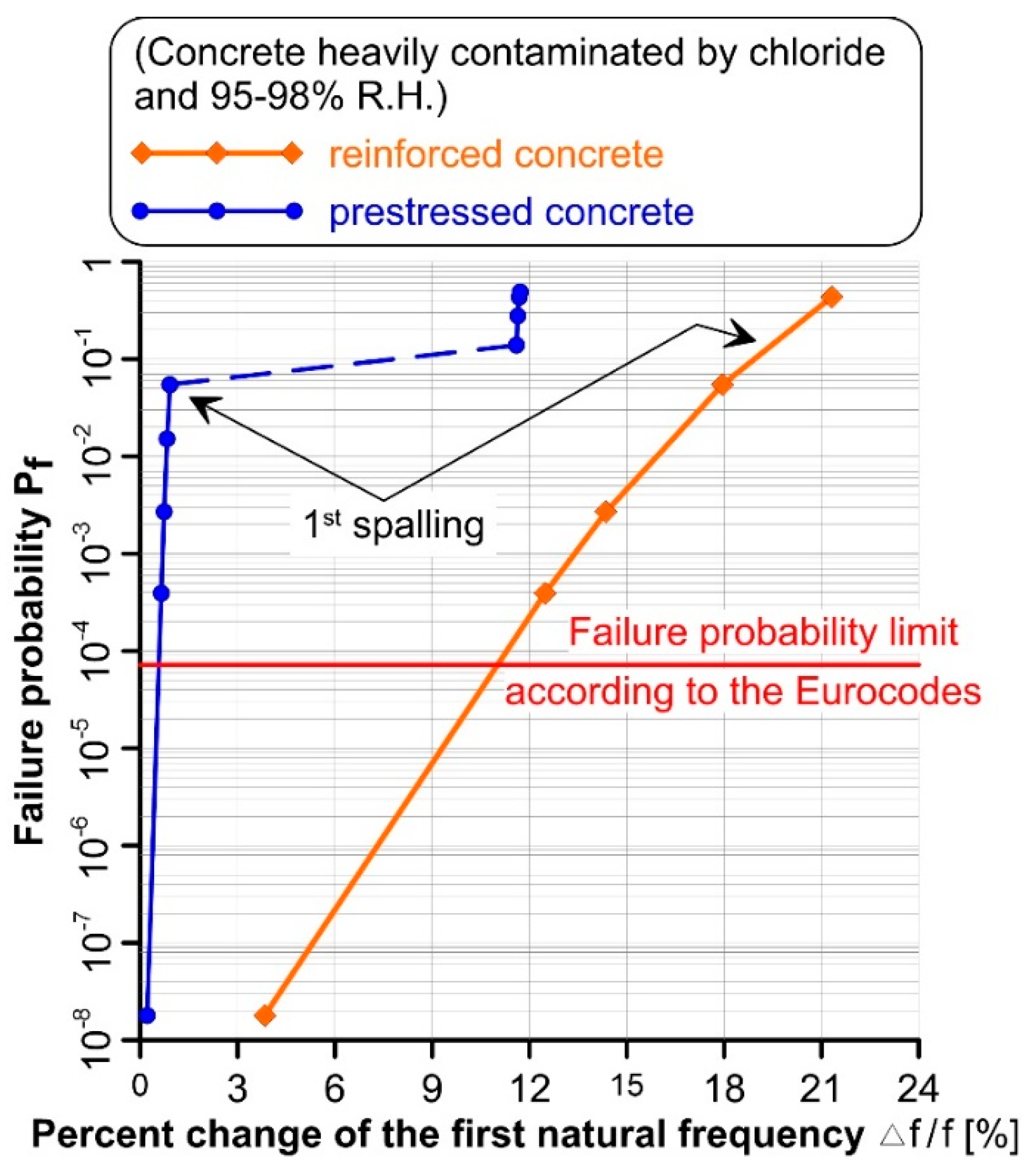
| Parameter | Very Aggressive Environment | Moderately Aggressive Environment | |
|---|---|---|---|
| = Chloride surface content | 2.8 | 1.37 | |
| = Chloride surface content | 0 | 0 | |
| = Chloride surface content | RC beam | 0.6 | 0.6 |
| PC beam | 0.2 | 0.2 | |
| = Chloride surface content | 5′10−12 | 5′10−12 | |
Publisher’s Note: MDPI stays neutral with regard to jurisdictional claims in published maps and institutional affiliations. |
© 2021 by the authors. Licensee MDPI, Basel, Switzerland. This article is an open access article distributed under the terms and conditions of the Creative Commons Attribution (CC BY) license (https://creativecommons.org/licenses/by/4.0/).
Share and Cite
Pisani, M.A.; Limongelli, M.P.; Giordano, P.F.; Palermo, M. On the Effectiveness of Vibration-Based Monitoring for Integrity Management of Prestressed Structures. Infrastructures 2021, 6, 171. https://doi.org/10.3390/infrastructures6120171
Pisani MA, Limongelli MP, Giordano PF, Palermo M. On the Effectiveness of Vibration-Based Monitoring for Integrity Management of Prestressed Structures. Infrastructures. 2021; 6(12):171. https://doi.org/10.3390/infrastructures6120171
Chicago/Turabian StylePisani, Marco Andrea, Maria Pina Limongelli, Pier Francesco Giordano, and Mattia Palermo. 2021. "On the Effectiveness of Vibration-Based Monitoring for Integrity Management of Prestressed Structures" Infrastructures 6, no. 12: 171. https://doi.org/10.3390/infrastructures6120171
APA StylePisani, M. A., Limongelli, M. P., Giordano, P. F., & Palermo, M. (2021). On the Effectiveness of Vibration-Based Monitoring for Integrity Management of Prestressed Structures. Infrastructures, 6(12), 171. https://doi.org/10.3390/infrastructures6120171








